The Interactive Impact of Building Diversity on the Thermal Balance and Micro-Climate Change under the Influence of Rapid Urbanization
Abstract
:1. Introduction
2. Materials and Methods
2.1. Long-Term and Mobile Observational Study Using SRST and GIS Analysis Together with the CFD Approach
- (a)
- Firstly, long-term observation [38] of meteorological data [39,40], climate factors [41], and remote sensing images [42] during the period 1980–2016 were applied and analyzed. For this purpose, raster maps of Wuhan City (8573 km2) at ten-yearly intervals from 1980 to 2016 were established and carefully analyzed using specified raster information. Afterwards, SRST coupled with GIS [43] approaches were used and data analyzed by ArcMap 10.4.1 (Esri China Information Technology Co. Ltd, Beijing, China) with the property of cell size (X, Y) and value 30, 30, and a spatial reference system of one meter. Accordingly, land-use changes were carefully assessed and measured due to the long-term impact of rapid urbanization [44]. In 2016, the urban land cover area was 709.9 km2, a 3.21 times increase from 220.5 km2 (1980) to about 489.3 km2 (2016) and the water surfaces (WS) [45] declined by 145.64 km2 (16% of the total range) in the urban area of Wuhan. As it was predicted [3], the rate of urbanism may reach 84% and the population of the built-up spaces will be 5.02 million, where the total population will increase by about 11.8 million. If the growth of the city continues on this trend, by 2020, the decrease has been predicted to be about 204.45 km2 (22%). On this point, we aimed to determine the long-term impact of the urbanization process on climate factors (Ta; air temperature, RH; relative humidity) to get the accrued data, which is needed to find the significant changes that have been linked with the greatest climate and land-use changes [46] over time during urban transformation.
- (b)
- As the second step, data collection for the long-term observational study [47] (1980–2016) was conducted from the weather stations at Huangpi (黄陂; 30°52′55.7″ N, 114°22′32.4″ E), Xinzhou (新洲; 30°50′26.2″ N, 114°48′03.2″ E), Caidian (蔡甸; 30°34′54.5″ N, 114°01′45.6″ E), and Jiangxia (江夏; 30°22′29.8″ N, 114°19′15.8″ E), which are available in the metrological bureau of Wuhan. Due to the long-term observation, tipping points were selected to represent the most significant changes regarding the transformation of water surfaces into urban construction land. Accordingly, and due to the major objective of this study, quantitative evaluation and measurement of these changes on the urban microclimate were undertaken in different residential urban blocks under the impact of UHII. These were classified as A, B and C; high-rise buildings (10–34 stories), mid-rise buildings (7–9 stories), and low-rise buildings (1–3 stories), respectively [36]. All the changes discovered in land-use transformation during Wuhan City’s urbanization from 1980 to 2016 can be seen in Figure 1.
- (c)
- The third step involved the mobile observation [48] of meteorological data, remote sensing images, and climate factors focusing on air temperature (Ta), relative humidity (RH), solar radiation, and wind. Therefore, in order to study the influence of block morphology (form and height) on urban microclimates, fixed and mobile observation was adopted [49]. The main equipment and instruments included a small weather station that included a wind speed and direction indicator, anemometer (placed 1.5 m above ground and using JTSOFT Meter V1.3 software to extract the data—(JT Technology, Beijing, China), a small portable temperature and humidity meter (data-logger using TRLog software to extract the data), mobile camcorder, and a handheld global positioning system (HhGPS). For the mobile observation approach, a walking method at a speed of 3 km/s for all blocks was used in the morning (5:30–6:30 am), at noon (13:00–14:00 pm), and in the evening (21:00–22:00 pm). Observations and measurements were recorded at the same time for all blocks within the area of 1 km.
- (d)
- The fourth step was a simulation method using CFD [50,51,52,53] analysis in which digital models of low-rise, mid-rise, and high-rise residential blocks were generated (using AutoCAD 2018—AUTODESK, California, USA) and a CFD domain [54] was set up after adding proper mesh [55] on models by ICEM-CFD 15. The study was performed to evaluate urban microclimates with the interactive impact of building diversity on the thermal balance that involves wind flow.
2.2. Modeling Using the CFD Technique
2.2.1. RANS Equation System (Setting up the Standard k-ε Model)
2.2.2. Computational Domain Size within the Urban Block Scale
3. Study Area and Setting
3.1. Study Area
3.2. Case Settings
3.3. Data Source
4. Results
4.1. The Impact of Land Use Change on UHII
4.2. The Impact of Urban Block Morphology on Urban Microclimates
4.3. CFD Simulation Results
- (a)
- The air change rates in cases A, B, and C are 3 m/s, 2.4 m/s, and 1.2 m/s, respectively. It shows that high-rise buildings with a high-value plot ratio can increase the air movement around the building and force the wind at the top of the buildings downwards to the earth.
- (b)
- The low-rise building model in the compact and dense area shows that heat gained during the day increases, but cannot be released efficiently and so increases the air temperature because of a lack of ventilation.
- (c)
- By reducing the air movement in the dense area in case C, relative humidity will decline substantially and increase UHII.
- (d)
- In the mid-rise building model, the air movement is almost at the average rate with a larger comfort zone, which is related to the proportion rate between building density and plot ratio.
- (e)
- Overall, building density is the most important morphological indicator to increase UHII compared with open spaces which, according to the plot ratio indicator, can reinforce air movement and increase natural ventilation to mitigate the negative effects of UHIIs.
5. Discussion
6. Conclusions
- (1)
- The UHII increased by 2 °C as a result of a 16% decrease in water surface area within the developed regions of Wuhan, and the wind speed decreased substantially because of an increase in urban land cover and a reduction in water surfaces in urban areas. This change in water surface area also caused a decline in both natural ventilation and air movement that could have alleviated UHII.
- (2)
- Wuhan urban land cover area has turned over three-fold compared to that of 1980, which consequently has enlarged the SUHI. This increase, with reduction in water surfaces in developed areas, has caused more heat gain, which has led to the destruction of the ecosystem and changed the heat balance and microclimate within urban blocks.
- (3)
- Investigations have shown that Wuhan is developing rapidly with more of a tendency to develop in the urban fringe, and if the city develops along the same lines, UHII will progressively increase and natural ventilation will dramatically decrease by 2020.
- (4)
- Urban morphology and block morphological indicators have a significant impact on microclimate and heat balance within the urban blocks, in which building density has the strongest effect on the environment, and plot ratio is another indicator that can intensify the air movement within the blocks. Depending on the combination of changes for the indicators, various changes can be found for air temperature and UHII. These indicators can mitigate UHII by controlling the air movement around the building.
Supplementary Materials
Author Contributions
Funding
Acknowledgments
Conflicts of Interest
References
- Arsiso, B.K.; Mengistu Tsidu, G.; Stoffberg, G.H.; Tadesse, T. Influence of urbanization-driven land use/cover change on climate: The case of Addis Ababa, Ethiopia. Phys. Chem. Earth Parts A/B/C 2018, 105, 212–223. [Google Scholar] [CrossRef]
- Dihkan, M.; Karsli, F.; Guneroglu, A.; Guneroglu, N. Evaluation of surface urban heat island (SUHI) effect on coastal zone: The case of Istanbul Megacity. Ocean Coast. Manag. 2015, 118, 309–316. [Google Scholar] [CrossRef]
- Li, X.; Li, B.; Chen, H. Study on the relationship between urban land sprawl extension and urban thermal environment—Taking Wuhan city as an example. Theor. Appl. Climatol. 2018. [Google Scholar] [CrossRef]
- Li, Y.; Jia, L.; Wu, W.; Yan, J.; Liu, Y. Urbanization for rural sustainability—Rethinking China’s urbanization strategy. J. Clean. Prod. 2018, 178, 580–586. [Google Scholar] [CrossRef]
- Wu, J.; Xie, H. Research on Characteristics of Changes of Lakes in Wuhan’s Main Urban Area. Procedia Eng. 2011, 21, 395–404. [Google Scholar] [CrossRef]
- Lindberg, F.; Onomura, S.; Grimmond, C.S.B. Influence of ground surface characteristics on the mean radiant temperature in urban areas. Int. J. Biometeorol. 2016, 60, 1439–1452. [Google Scholar] [CrossRef]
- Li, H.; Zhou, Y.; Wang, X.; Zhou, X.; Zhang, H.; Sodoudi, S. Quantifying urban heat island intensity and its physical mechanism using WRF/UCM. Sci. Total Environ. 2019, 650, 3110–3119. [Google Scholar] [CrossRef]
- Noro, M.; Lazzarin, R. Urban heat island in Padua, Italy: Simulation analysis and mitigation strategies. Urban Clim. 2015, 14, 187–196. [Google Scholar] [CrossRef]
- Wang, C.; Wang, Y.; Wang, R.; Zheng, P. Modeling and evaluating land-use/land-cover change for urban planning and sustainability: A case study of Dongying city, China. J. Clean. Prod. 2018, 172, 1529–1534. [Google Scholar] [CrossRef]
- Salazar, A.; Baldi, G.; Hirota, M.; Syktus, J.; McAlpine, C. Land use and land cover change impacts on the regional climate of non-Amazonian South America: A review. Glob. Planet. Chang. 2015, 128, 103–119. [Google Scholar] [CrossRef]
- Garuma, G.F.; Blanchet, J.-P.; Girard, É.; Leduc, M. Urban surface effects on current and future climate. Urban Clim. 2018, 24, 121–138. [Google Scholar] [CrossRef]
- Garuma, G.F. Review of urban surface parameterizations for numerical climate models. Urban Clim. 2018, 24, 830–851. [Google Scholar] [CrossRef]
- Lee, D.; Oh, K. Classifying urban climate zones (UCZs) based on statistical analyses. Urban Clim. 2018, 24, 503–516. [Google Scholar] [CrossRef]
- Gaur, A.; Eichenbaum, M.K.; Simonovic, S.P. Analysis and modelling of surface Urban Heat Island in 20 Canadian cities under climate and land-cover change. J. Environ. Manag. 2018, 206, 145–157. [Google Scholar] [CrossRef] [PubMed]
- Taleghani, M.; Crank, P.J.; Mohegh, A.; Sailor, D.J.; Ban-Weiss, G.A. The impact of heat mitigation strategies on the energy balance of a neighborhood in Los Angeles. Sol. Energy 2019, 177, 604–611. [Google Scholar] [CrossRef]
- Rashdi, W.S.S.W.M.; Embi, M.R. Analysing Optimum Building form in Relation to Lower Cooling Load. Procedia Soc. Behav. Sci. 2016, 222, 782–790. [Google Scholar] [CrossRef]
- Cheng, J.; Qi, D.; Katal, A.; Wang, L.; Stathopoulos, T. Evaluating wind-driven natural ventilation potential for early building design. J. Wind Eng. Ind. Aerodyn. 2018, 182, 160–169. [Google Scholar] [CrossRef]
- Gu, Y.; Li, D. A modeling study of the sensitivity of urban heat islands to precipitation at climate scales. Urban Clim. 2018, 24, 982–993. [Google Scholar] [CrossRef]
- Levermore, G.; Parkinson, J.; Lee, K.; Laycock, P.; Lindley, S. The increasing trend of the urban heat island intensity. Urban Clim. 2018, 24, 360–368. [Google Scholar] [CrossRef]
- Zhou, X.; Chen, H. Impact of urbanization-related land use land cover changes and urban morphology changes on the urban heat island phenomenon. Sci. Total Environ. 2018, 635, 1467–1476. [Google Scholar] [CrossRef]
- Pakarnseree, R.; Chunkao, K.; Bualert, S. Physical characteristics of Bangkok and its urban heat island phenomenon. Build. Environ. 2018, 143, 561–569. [Google Scholar] [CrossRef]
- Zhou, Y.; Zhuang, Z.; Yang, F.; Yu, Y.; Xie, X. Urban morphology on heat island and building energy consumption. Procedia Eng. 2017, 205, 2401–2406. [Google Scholar] [CrossRef]
- Liu, M.; Zhong, Y.; Tan, J. Impact of Urban Planning Indicator on Spatial Distribution of Residential Heating and Cooling Energy Demand. Procedia Eng. 2017, 205, 959–966. [Google Scholar] [CrossRef]
- Dimoudi, A.; Kantzioura, A.; Zoras, S.; Pallas, C.; Kosmopoulos, P. Investigation of urban microclimate parameters in an urban center. Energy Build. 2013, 64, 1–9. [Google Scholar] [CrossRef]
- Yin, C.; Yuan, M.; Lu, Y.; Huang, Y.; Liu, Y. Effects of urban form on the urban heat island effect based on spatial regression model. Sci. Total Environ. 2018, 634, 696–704. [Google Scholar] [CrossRef]
- Guo, G.; Zhou, X.; Wu, Z.; Xiao, R.; Chen, Y. Characterizing the impact of urban morphology heterogeneity on land surface temperature in Guangzhou, China. Environ. Model. Softw. 2016, 84, 427–439. [Google Scholar] [CrossRef]
- Feyisa, G.L.; Meilby, H.; Darrel Jenerette, G.; Pauliet, S. Locally optimized separability enhancement indices for urban land cover mapping: Exploring thermal environmental consequences of rapid urbanization in Addis Ababa, Ethiopia. Remote Sens. Environ. 2016, 175, 14–31. [Google Scholar] [CrossRef]
- O’Malley, C.; Piroozfar, P.; Farr, E.R.P.; Pomponi, F. Urban Heat Island (UHI) mitigating strategies: A case-based comparative analysis. Sustain. Cities Soc. 2015, 19, 222–235. [Google Scholar] [CrossRef]
- Hu, Y.; White, M.; Ding, W. An Urban Form Experiment on Urban Heat Island Effect in High Density Area. Procedia Eng. 2016, 169, 166–174. [Google Scholar] [CrossRef]
- Ngie, A.; Abutaleb, K.; Ahmed, F.; Taiwo, O. Spatial modelling of urban change using satellite remote sensing: A review. In Proceedings of the IGU Urban Geography Commission, Johannesburg, South Africa, 21–26 July 2013; Available online: https://www.researchgate.net/publication/272183077_Spatial_modelling_of_urban_change_using_satellite_remote_sensing_a_review (accessed on 10 February 2019). [CrossRef]
- Chen, J.; Fan, W.; Li, K.; Liu, X.; Song, M. Fitting Chinese cities’ population distributions using remote sensing satellite data. Ecol. Indic. 2019, 98, 327–333. [Google Scholar] [CrossRef]
- Chen, W.; Zhang, Y.; Gao, W.; Zhou, D. The Investigation of Urbanization and Urban Heat Island in Beijing Based on Remote Sensing. Procedia Soc. Behav. Sci. 2016, 216, 141–150. [Google Scholar] [CrossRef]
- Langat, P.K.; Kumar, L.; Koech, R. Monitoring river channel dynamics using remote sensing and GIS techniques. Geomorphology 2019, 325, 92–102. [Google Scholar] [CrossRef]
- Kar, R.; Obi Reddy, G.P.; Kumar, N.; Singh, S.K. Monitoring spatio-temporal dynamics of urban and peri-urban landscape using remote sensing and GIS—A case study from Central India. Egypt. J. Remote Sens. Space Sci. 2018, 21, 401–411. [Google Scholar] [CrossRef]
- Kim, H.; Gu, D.; Kim, H.Y. Effects of Urban Heat Island mitigation in various climate zones in the United States. Sustain. Cities Soc. 2018, 41, 841–852. [Google Scholar] [CrossRef]
- Mavridou, M.; Hoelscher, C.; Kalff, C. The impact of Different Building Height Configurations on Navigation and Wayfinding. In Proceedings of the 7th International Space Syntax Symposium: Proceedings, Stockholm, Sweden, 8–11 June 2009; KTH Royal Institute of Technology: Stockholm, Sweden, 2009. [Google Scholar]
- Chang, S. Integrating CFD and GIS into the Development of Urban Ventilation Corridors: A Case Study in Changchun City, China. Sustainability 2018, 10, 1814. [Google Scholar] [CrossRef]
- Song, S.; Xu, Y.P.; Zhang, J.X.; Li, G.; Wang, Y.F. The long-term water level dynamics during urbanization in plain catchment in Yangtze River Delta. Agric. Water Manag. 2016, 174, 93–102. [Google Scholar] [CrossRef]
- Gui, K.; Che, H.; Wang, Y.; Wang, H.; Zhang, L.; Zhao, H.; Zheng, Y.; Sun, T.; Zhang, X. Satellite-derived PM2.5 concentration trends over Eastern China from 1998 to 2016: Relationships to emissions and meteorological parameters. Environ. Pollut. 2019, 247, 1125–1133. [Google Scholar] [CrossRef]
- Shi, T.; Huang, Y.; Wang, H.; Shi, C.-E.; Yang, Y.-J. Influence of urbanization on the thermal environment of meteorological station: Satellite-observed evidence. Adv. Clim. Chang. Res. 2015, 6, 7–15. [Google Scholar] [CrossRef]
- Du, Y.-D.; Ai, H.; Duan, H.-L.; Hu, Y.-M.; Wang, X.-W.; He, J.; Wu, H.-Y.; Wu, X.-X. Changes in Climate Factors and Extreme Climate Events in South China during 1961–2010. Adv. Clim. Chang. Res. 2013, 4, 1–11. [Google Scholar] [CrossRef]
- Wang, W.; Liu, K.; Tang, R.; Wang, S. Remote sensing image-based analysis of the urban heat island effect in Shenzhen, China. Phys. Chem. Earth Parts A/B/C 2019. [Google Scholar] [CrossRef]
- Zheng, Y.; Ren, C.; Xu, Y.; Wang, R.; Ho, J.; Lau, K.; Ng, E. GIS-based mapping of Local Climate Zone in the high-density city of Hong Kong. Urban Clim. 2018, 24, 419–448. [Google Scholar] [CrossRef]
- Mahmoud, S.H.; Gan, T.Y. Long-term impact of rapid urbanization on urban climate and human thermal comfort in hot-arid environment. Build. Environ. 2018, 142, 83–100. [Google Scholar] [CrossRef]
- Zhang, F.; Zhan, J.; Li, Z.; Jia, S.; Chen, S. Impacts of urban transformation on water footprint and sustainable energy in Shanghai, China. J. Clean. Prod. 2018, 190, 847–853. [Google Scholar] [CrossRef]
- Cai, D.; Fraedrich, K.; Guan, Y.; Guo, S.; Zhang, C.; Zhu, X. Urbanization and climate change: Insights from eco-hydrological diagnostics. Sci. Total Environ. 2019, 647, 29–36. [Google Scholar] [CrossRef] [PubMed]
- Wai, K.M.; Wang, X.M.; Lin, T.H.; Wong, M.S.; Zeng, S.K.; He, N.; Ng, E.; Lau, K.; Wang, D.H. Observational evidence of a long-term increase in precipitation due to urbanization effects and its implications for sustainable urban living. Sci. Total Environ. 2017, 599–600, 647–654. [Google Scholar] [CrossRef] [PubMed]
- Guo, L.; Li, B. Observation and Analysis of Urban Micro-Climate and Urban Morphology on Block Scale in Zhengzhou City. World Acad. Sci. Eng. Technol. Int. J. Mar. Environ. Sci. 2018, 12, 5. [Google Scholar]
- Sato, T.; Ooka, R.; Murakami, S. Analysis of sensible heat, latent heat and mean kinetic energy balance of moving control volume along sea breeze based on meso-scale climate simulation. J. Environ. Eng. 2004, 73, 1029–1035. (In Japanese) [Google Scholar] [CrossRef]
- Nazarian, N.; Kleissl, J. CFD simulation of an idealized urban environment: Thermal effects of geometrical characteristics and surface materials. Urban Clim. 2015, 12, 141–159. [Google Scholar] [CrossRef]
- Thordal, M.S.; Bennetsen, J.C.; Koss, H.H.H. Review for practical application of CFD for the determination of wind load on high-rise buildings. J. Wind Eng. Ind. Aerodyn. 2019, 186, 155–168. [Google Scholar] [CrossRef]
- Mompean, G. Numerical simulation of a turbulent flow near a right-angled corner using the Speziale non-linear model with RNG K–ε equations. Comput. Fluids 1998, 27, 847–859. [Google Scholar] [CrossRef]
- Shuojun, M.; Jingjing, C.; Jiangtao, H.; Jihao, Z.; Lirong, T.; Fuyun, Z. Numerical simulation of urban ventilation with different building scales. In Proceedings of the 2014 ISFMFE—6th International Symposium on Fluid Machinery and Fluid Engineering, Wuhan, China, 22–22 October 2014; pp. 1–6. [Google Scholar]
- Khalilzadeh, A.; Ge, H.; Ng, H.D. Effect of turbulence modeling schemes on wind-driven rain deposition on a mid-rise building: CFD modeling and validation. J. Wind Eng. Ind. Aerodyn. 2019, 184, 362–377. [Google Scholar] [CrossRef]
- Houda, S.; Belarbi, R.; Zemmouri, N. A CFD Comsol model for simulating complex urban flow. Energy Procedia 2017, 139, 373–378. [Google Scholar] [CrossRef]
- Song, J.; Meng, X. The Improvement of Ventilation Design in School Buildings Using CFD Simulation. Procedia Eng. 2015, 121, 1475–1481. [Google Scholar] [CrossRef]
- Pakzad, E.; Salari, N. Measuring sustainability of urban blocks: The case of Dowlatabad, Kermanshah city. Cities 2018, 75, 90–100. [Google Scholar] [CrossRef]
- Tominaga, Y.; Mochida, A.; Murakami, S.; Sawaki, S. Comparison of various revised k-ε models and LES applied to flow around a high-rise building model with 1:1:2 shape placed within the surface boundary layer. J. Wind Eng. Ind. Aerodyn. 2008, 96, 389–411. [Google Scholar] [CrossRef]
- Salman Ali, a.B.L. Evaluating the Impact of the Morphological Transformation of Urban Sites on the Urban Thermal Microenvironment. Buildings 2018, 8, 182. [Google Scholar]
- Zhang, L.; Zhang, M.; Yao, Y. Mapping seasonal impervious surface dynamics in Wuhan urban agglomeration, China from 2000 to 2016. Int. J. Appl. Earth Obs. Geoinform. 2018, 70, 51–61. [Google Scholar] [CrossRef]
- Mehdi Makvandi, B.L.; Zhu, J. Natural ventilation design strategy through CFD approach to mitigate the negative effects of microclimate changes due to the urbanization in urban block scale at Wuhan city fringe (part 3). In Proceedings of the 3rd International Conference on Urban Management Civil Engineering and Technology in Moderm Architecture, Amsterdam, The Netherlands, 16 July 2018. [Google Scholar]
- Toparlar, Y.; Blocken, B.; Maiheu, B.; van Heijst, G.J.F. A review on the CFD analysis of urban microclimate. Renew. Sustain. Energy Rev. 2017, 80, 1613–1640. [Google Scholar] [CrossRef]
- Yang, Y.; Liu, J.; Lin, Y.; Li, Q. The impact of urbanization on China’s residential energy consumption. Struct. Chang. Econ. Dyn. 2018. [Google Scholar] [CrossRef]
- Wei, R.; Song, D.; Wong, N.H.; Martin, M. Impact of Urban Morphology Parameters on Microclimate. Procedia Eng. 2016, 169, 142–149. [Google Scholar] [CrossRef]
- Niu, W.Y. China New Urbanization Report; Science Press: Beijing, China, 2013. [Google Scholar]
- Huang, Q.; Huang, J.; Yang, X.; Fang, C.; Liang, Y. Quantifying the seasonal contribution of coupling urban land use types on Urban Heat Island using Land Contribution Index: A case study in Wuhan, China. Sustain. Cities Soc. 2019, 44, 666–675. [Google Scholar] [CrossRef]
- Wang, B.; Sun, S.; Duan, M. Wind potential evaluation with urban morphology—A case study in Beijing. Energy Procedia 2018, 153, 62–67. [Google Scholar] [CrossRef]
- Hu, L.; Brunsell, N.A. The impact of temporal aggregation of land surface temperature data for surface urban heat island (SUHI) monitoring. Remote Sens. Environ. 2013, 134, 162–174. [Google Scholar] [CrossRef]
- Cosar-Jorda, P.; Buswell, R.A.; Mitchell, V.A. Determining of the role of ventilation in residential energy demand reduction using a heat-balance approach. Build. Environ. 2018, 144, 508–518. [Google Scholar] [CrossRef]

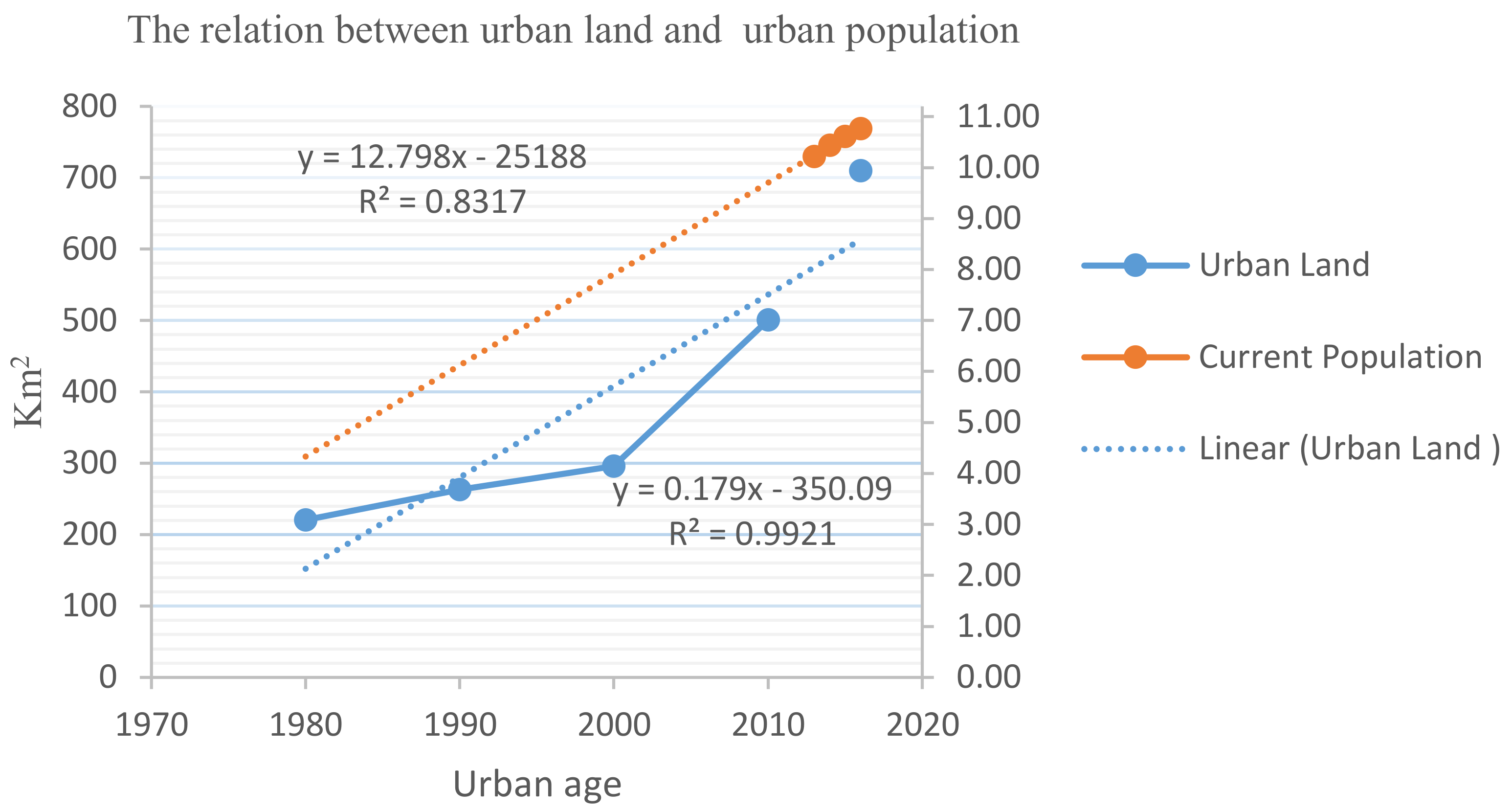


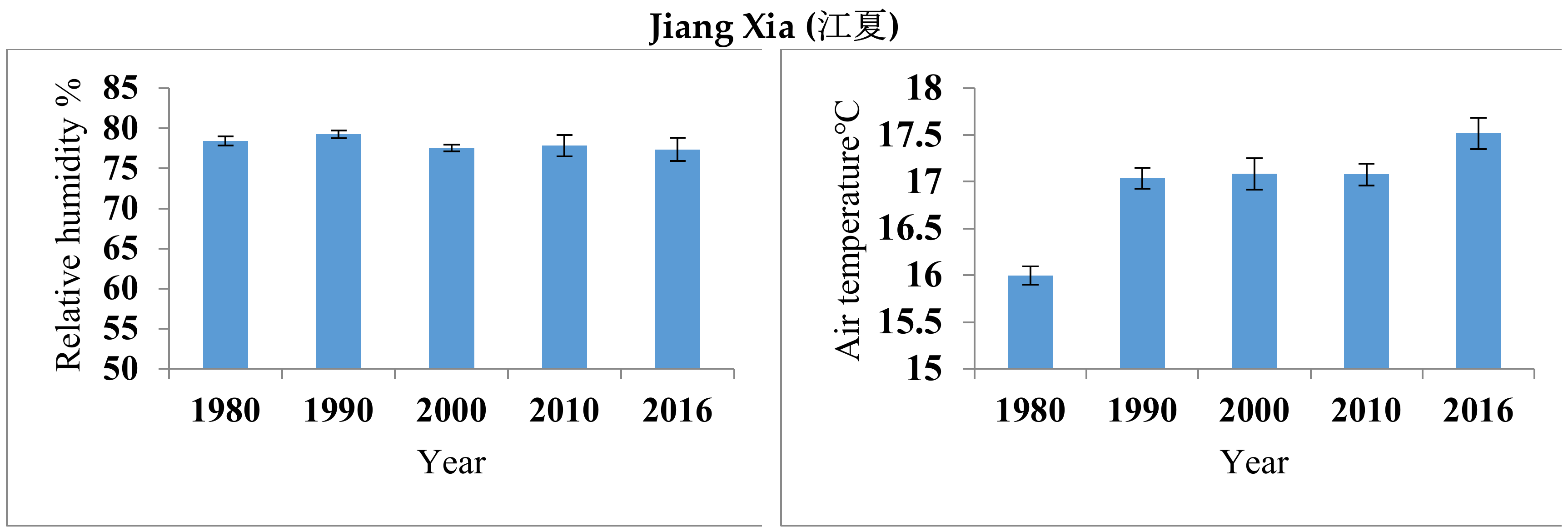
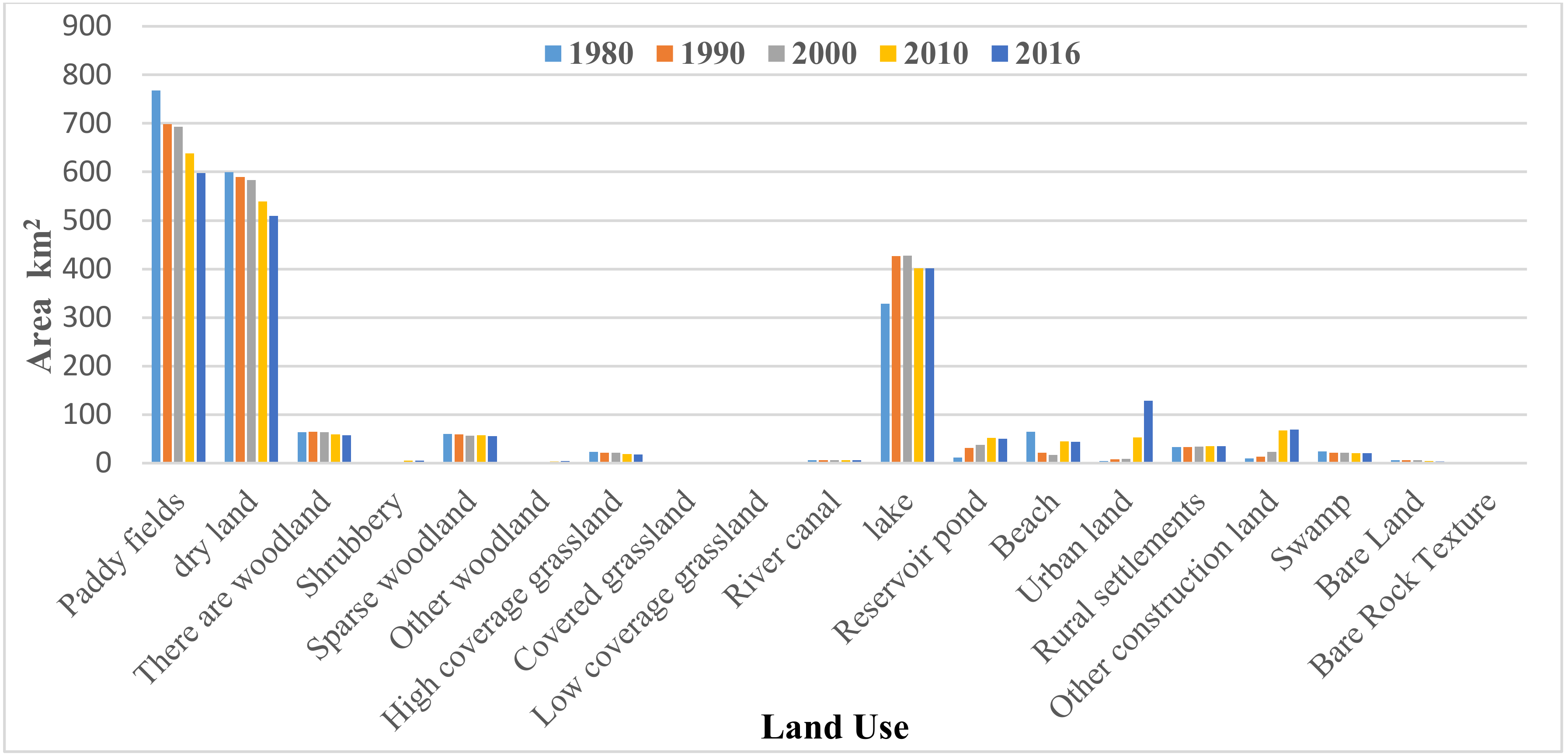
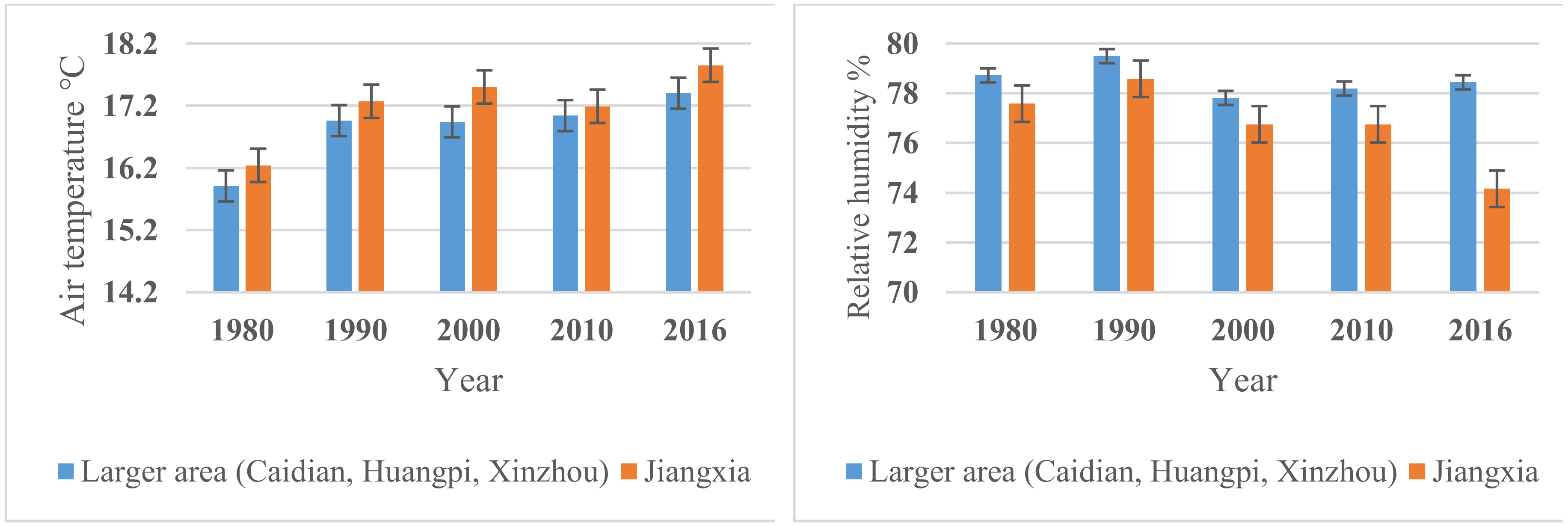
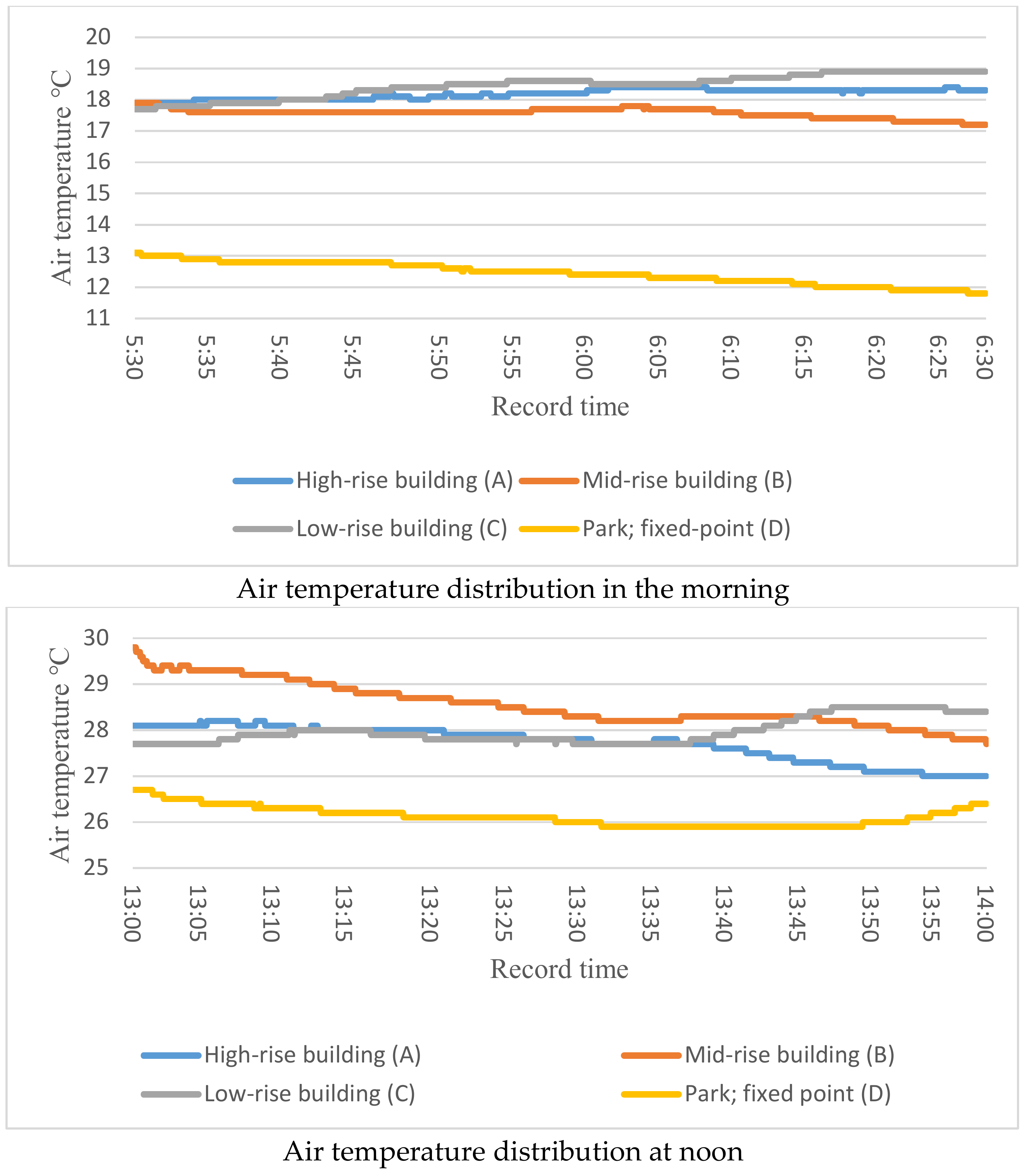
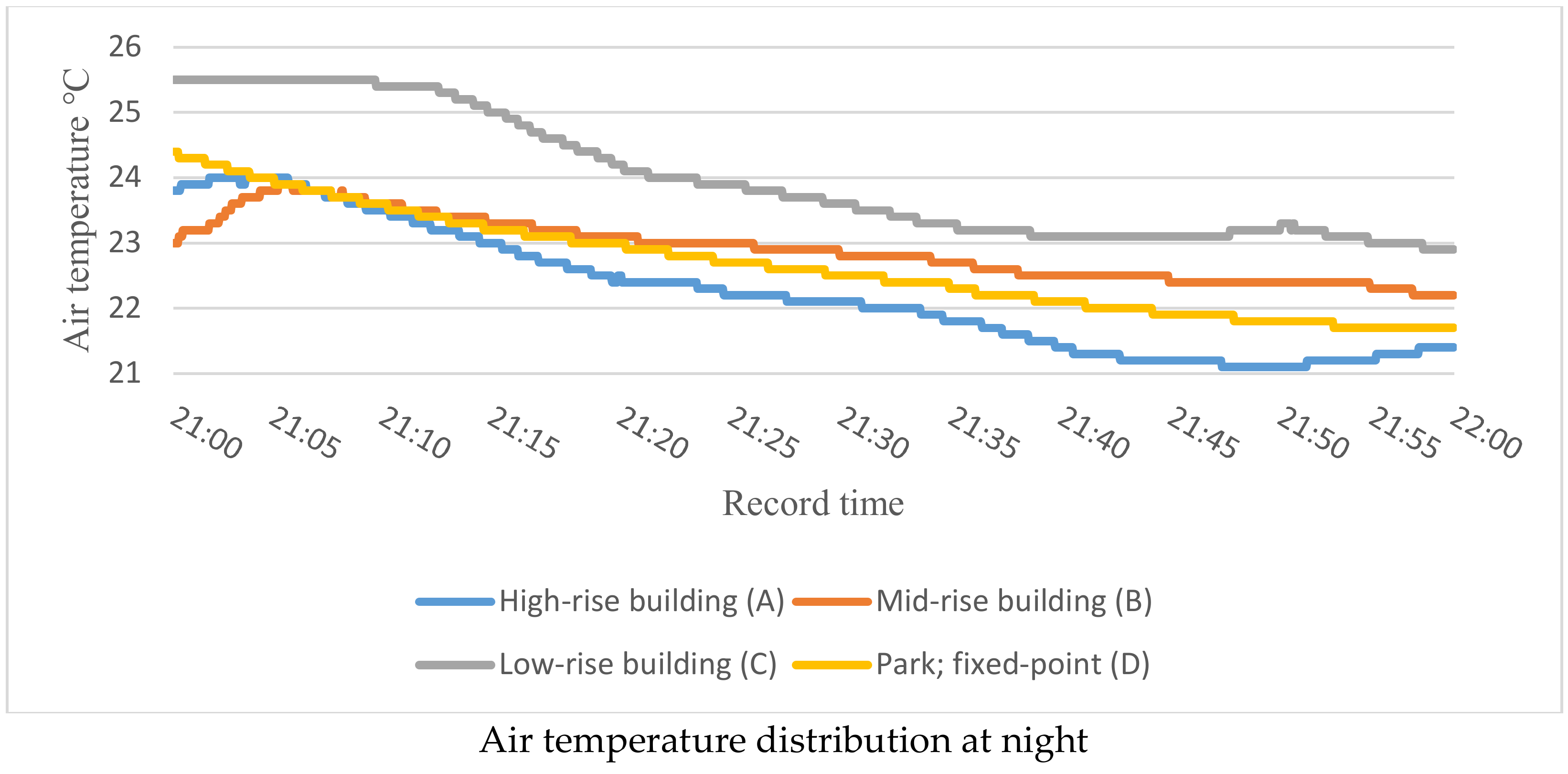
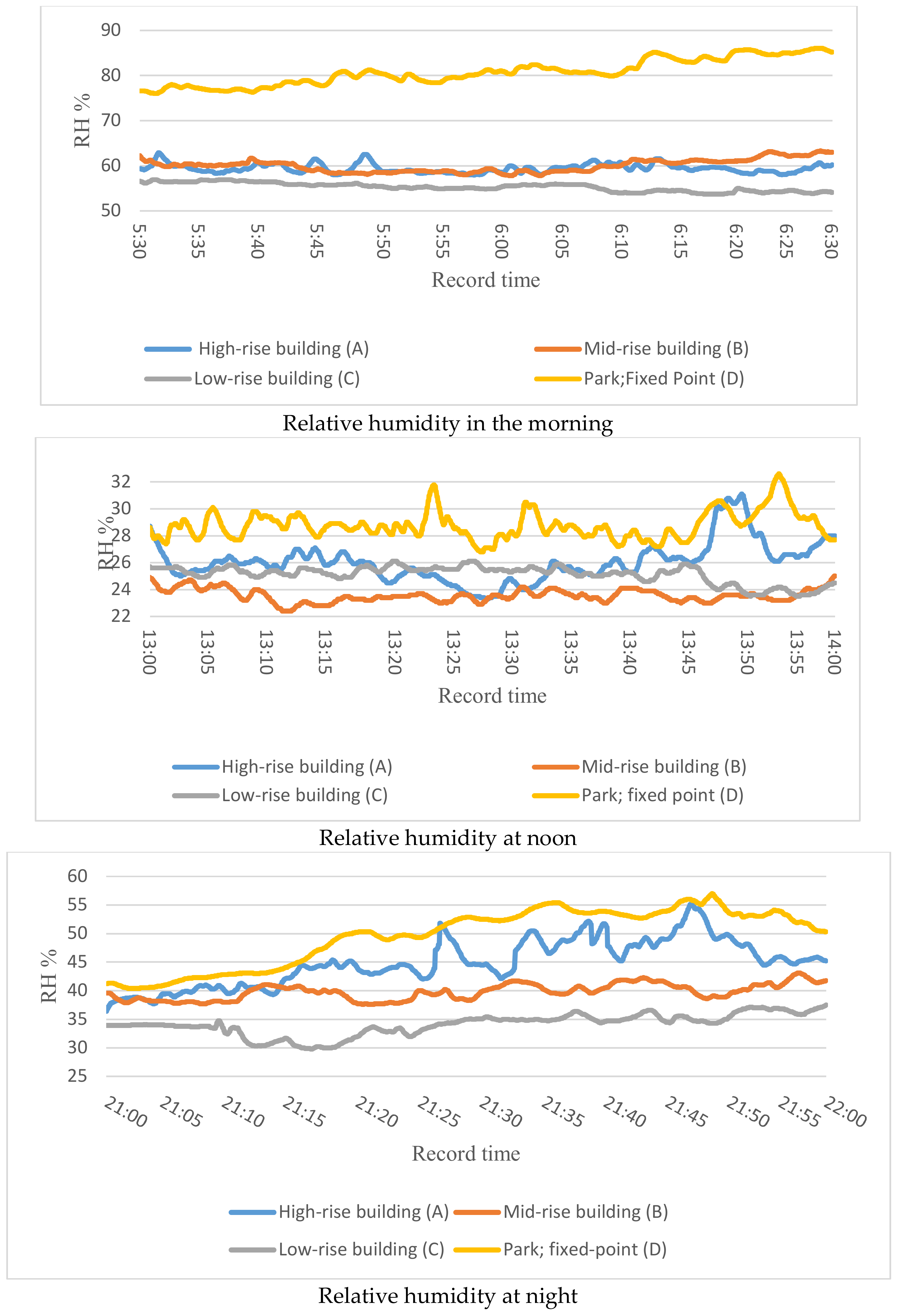

| Constant | Value |
|---|---|
| Cµ | 0.09 |
| Ce1 | 1.44 |
| Ce2 | 1.92 |
| σk | 1.0 |
| σε | 1.3 |
| Cases | Observation Technique | Building Types | Building Density (Built-up Area/Total Site Area) (%) | Plot Ratio (Gross Floor Area/Total Site Area) | Greenery Ratio (Green Area/Total Site Area) (%) | Water Area Reduction (km2) |
|---|---|---|---|---|---|---|
| A | Mobile observation | High-rise (10~34 story building) | 19 | 16.6 | 19 | - |
| B | Mid-rise (7~9 story building) | 21 | 5.6 | 25 | - | |
| C | Low- rise (1~3 story building) | 23 | 2.1 | 13 | - | |
| D | Fixed observation | Park | - | 1.6 | 80 | 4.5 (7.2%) |
| Wuhan (LU/LC) | Long-term observation (1980–2016) | Building/urban morphology | - | - | 136.4 reduction | 145.64 (16% of the total range) |
| Cases | Categories/Types | Time Record | Moring (5:30–6:30) | Noon (1:00–2:00) | Night (9:00–10:00) |
|---|---|---|---|---|---|
| A | High-rise Building | SR | 18 | 28.1 | 23.8 |
| ER | 18.4 | 27 | 21.4 | ||
| B | Mid-rise Building | SR | 18 | 29.5 | 23 |
| ER | 17.2 | 27.7 | 22.2 | ||
| C | Low-rise Building | SR | 17.8 | 27.6 | 25.5 |
| ER | 18.9 | 28.4 | 22.9 | ||
| D | Park | SR | 13.2 | 26.7 | 24.4 |
| ER | 11.8 | 26.4 | 22.7 | ||
 | |||||
© 2019 by the authors. Licensee MDPI, Basel, Switzerland. This article is an open access article distributed under the terms and conditions of the Creative Commons Attribution (CC BY) license (http://creativecommons.org/licenses/by/4.0/).
Share and Cite
Makvandi, M.; Li, B.; Elsadek, M.; Khodabakhshi, Z.; Ahmadi, M. The Interactive Impact of Building Diversity on the Thermal Balance and Micro-Climate Change under the Influence of Rapid Urbanization. Sustainability 2019, 11, 1662. https://doi.org/10.3390/su11061662
Makvandi M, Li B, Elsadek M, Khodabakhshi Z, Ahmadi M. The Interactive Impact of Building Diversity on the Thermal Balance and Micro-Climate Change under the Influence of Rapid Urbanization. Sustainability. 2019; 11(6):1662. https://doi.org/10.3390/su11061662
Chicago/Turabian StyleMakvandi, Mehdi, Baofeng Li, Mohamed Elsadek, Zeinab Khodabakhshi, and Mohsen Ahmadi. 2019. "The Interactive Impact of Building Diversity on the Thermal Balance and Micro-Climate Change under the Influence of Rapid Urbanization" Sustainability 11, no. 6: 1662. https://doi.org/10.3390/su11061662






